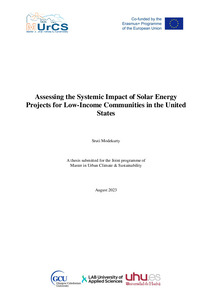Assessing the systemic impact of solar energy projects for low-income communities in the United States
Modekurty, Sruti (2023)
Modekurty, Sruti
2023
Julkaisun pysyvä osoite on
https://urn.fi/URN:NBN:fi:amk-2023120133322
https://urn.fi/URN:NBN:fi:amk-2023120133322
Tiivistelmä
Equitable solutions are needed to address the climate crisis, as the impacts go beyond environmental challenges. Deploying solar in low-income communities addresses emissions mitigation, while providing benefits such as reducing energy costs, improving air quality and creating jobs. This research studied the potential impact of a new bonus federal tax credit focused on solar deployments in low-income communities in the United States, passed as part of the Inflation Reduction Act (IRA). Existing datasets on technical solar potential, demographic, and economic data were combined at the census level to predict and assess possible benefits. The research focused on urban, low-income tracts eligible for the income tax credit under the IRA requirements. First, feasibility and impact scores were calculated based on common barriers for solar adoption and socio-economic factors which negatively impact communities such as energy burdens and high PM2.5 levels. This created a baseline of current conditions and ranked areas for suitability and potential for positive change. Next, adoption was predicted under several scenarios adressing the IRA incentive. Generation capacity and potential were then calculated yearly until the end of the program in 2033. Finally, avoided emissions, jobs created, and energy burden changes were calculated based on these values. Analysis was carried out at the census level but were aggregated to discuss trends at the state level. With high feasibility scores, high technical potential and currently low adoption, census tracts in Illinois are prime potential targets for the tax credit (LITC). Areas in the Southeast could highly benefit from the LITC but only if feasibility issues regarding policies are fixed. Added capacity and generation potential values, were lower than expected, possibly due to conservative adoption modeling. Over the course of the program, the IRA incentive could result in 41.3GW of added capacity, 119,770 new clean energy jobs, and 35 million metric tons of CO2 emissions avoided. However, significantly reducing energy burden is only possible if the cost of installation was reduced beyond the 40% tax credit. Without other incentives, households would be paying off the cost of the installation for 10-20 years. This means that even with the incentive, installation cost can still be a huge barrier for many. While there are benefits to deploying solar projects, the effects at a census tract level are quite small. At a larger scale, and cumulatively over the effect of the program, the benefits are more tangible. Regardless, targeted outreach to communities to install solar projects would results in positive outcomes for many people. The work produced open, actionable datasets for stakeholders to evaluate where to focus efforts and how to complement the policy for optimal success.
